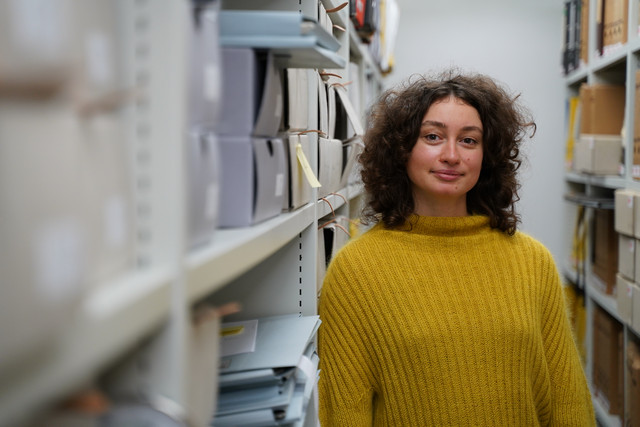Main Content
Architectural Historian Ksenia Litvinenko Joins IRS as Fellow
Project on the Utilisation of "Nomadic Architecture" in the Soviet Union in Preparation
On 1 October 2023 the historian of architecture Ksenia Litvinenko joined the IRS as a Fellow within the Leibniz Research Alliance “Values of the Past”. Under the mentorship of Monika Motylińska, she is in the process of developing a research project titled “Resourcification of Nomadic Indigenous Heritage in the Soviet Projects of Mobile Architecture”. The project will explore how the Soviet Union sought to utilise “Nomadic Architecture” to create mobile settlements for workers in the oil and gas industries in Siberia.

In 1980, the researcher of Kalmyk architecture and later chief architect of the USSR's space agency Glavkosmos, Dzangar Purveev, and the first deputy chair of the Council of Ministers of the Mongolian People’s Republic (MPR), Damdinjav Maidar, co-authored and published a book titled “From Nomadic to Mobile Architecture.” This seminal volume, which remains largely unknown in the historiography of late Soviet architecture, stated that “experience of nomadic architecture can be used for the benefit of the scientific and technological revolution” in state socialist countries as they approach Communism. Observing vernacular building techniques still practised in some communities in the Soviet Union and the MPR, authors praised "nomadic architecture’s" quality to "adapt" to extreme weather conditions, its cost and energy effectiveness, as well as portability, which was especially valued due to the forecasted mass proliferation of private automobiles, tourism, and development of extractive infrastructures in hard-to-reach areas.
Maidar and Purveev argued that, if properly "modernised," the "nomadic architecture" of the Soviet Union and the MPR could serve as a basis for new socialist mobile urbanism. Such a new type of urbanism assumed temporary and – potentially – portable "shift" settlements built from barracks or mobile living units. In the Soviet Union, such a settlement strategy was employed in Western Siberia to facilitate the arrival of skilled labourers to newly discovered oil and gas fields throughout the region. The intensification of their migration facilitated the ongoing displacement of indigenous ethnic minorities – Khakass, Khanti, Mansi, Yupik, Nenets and others – from their ancestral lands and hunting, herding and fishing grounds to settled or semi-settled rural "collective centres".
Taking Maidar and Purveev’s 1980 forecast as a starting point, the research project "Resourcification of Nomadic Indigenous Heritage in the Soviet Projects of Mobile Architecture" aims to critically interrogate the legacies of late Soviet extractive urbanism, related architectural epistemology and the changing perception of the place of indigenous communities in the project of Soviet modernity. Through the analysis of published reports and experimental research projects of Soviet design and research institutes involved in the development of designs and forecasts for the so-called "mobile architecture" as well as a close reading of the ethnographic studies conducted in Western Siberia during the 1970s-80s, the research examines how the indigenous portable building techniques were essentialised and framed as a "resource" in the design of Soviet mobile architecture for industrial extraction, workers’ recreation, or collectivised herding. Offering a complex perspective on internal hierarchies of knowledge and power in the Soviet Union and how they manifested spatially, the project aims to arrive at a more nuanced understanding of the involvement of architectural expertise and practice in state-sponsored settler- and extractivist expansion and displacement in Western Siberia.
Dr. Ksenia Litvinenko is a historian of architecture. She received a Ph.D. in architecture from the University of Manchester in 2023, supported by the President’s Doctoral Scholar Award and the German Historical Institute Doctoral Fellowship. Her PhD thesis worked with and through dispersed archives of the Giproteatr Design and Research Institute, one of the most influential organisations behind the mass construction and refurbishment of buildings for culture and performing arts in the Soviet Union and abroad. Litvinenko’s current personal and collaborative research concerns the institutional history of the architectural profession in the transnational Socialist Bloc, mobilities of architecture, technology, and knowledge in the last decades of the Cold War, and architectural governance of mobility and sedentism. For the duration of her placement at the IRS, Litvinenko collaborates with the Research Group "Histories of the Built Environment" led by Dr Monika Motylińska to facilitate scientific exchange and strengthen comparative perspectives on the German and Soviet frameworks for the twentieth-century global architectural mobilities.

